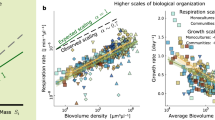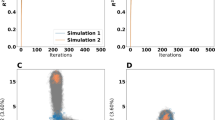Abstract
Understanding the allocation of metabolic energy between the sustenance of an organism and its growth is an important issue in ecology. West et al.1 have built on their earlier attempts to explain the exponent for the allometric scaling of metabolism and have derived a single, parameterless universal curve that describes the growth of many species. Here we show that the universal curve arises from general considerations that are independent of the specific allometric model used by West et al. and that the data do not distinguish between a 3/4 or 2/3 exponent in the relationship between metabolic rate and mass scaling.
This is a preview of subscription content, access via your institution
Access options
Subscribe to this journal
Receive 51 print issues and online access
$199.00 per year
only $3.90 per issue
Buy this article
- Purchase on SpringerLink
- Instant access to full article PDF
Prices may be subject to local taxes which are calculated during checkout

Similar content being viewed by others
References
West, G. B., Brown, J. H. & Enquist, B. J. Nature 413, 628–631 (2001).
von Bertalanffy, L. Q. Rev. Biol. 32, 217–231 (1957).
Author information
Authors and Affiliations
Corresponding author
Rights and permissions
About this article
Cite this article
Banavar, J., Damuth, J., Maritan, A. et al. Modelling universality and scaling. Nature 420, 626 (2002). https://doi.org/10.1038/420626a
Issue date:
DOI: https://doi.org/10.1038/420626a
This article is cited by
-
Modelling von Bertalanffy growth function of fish with fractals
Hydrobiologia (2024)
-
Universal ontogenetic growth without fitted parameters: implications for life history invariants and population growth
Theoretical Ecology (2023)
-
Explorability and the origin of network sparsity in living systems
Scientific Reports (2017)
-
Determinants of inter-specific variation in basal metabolic rate
Journal of Comparative Physiology B (2013)
-
On the Structure-Bounded Growth Processes in Plant Populations
Cell Biochemistry and Biophysics (2010)



